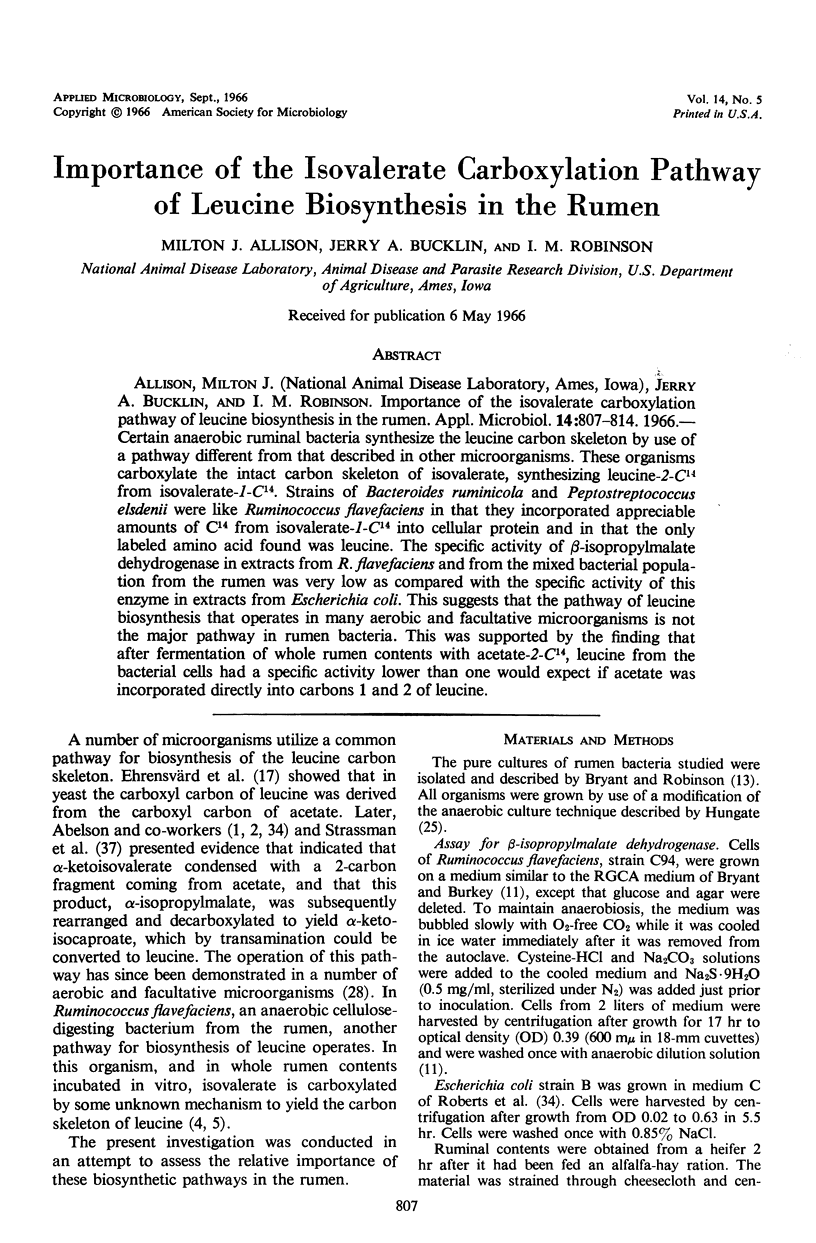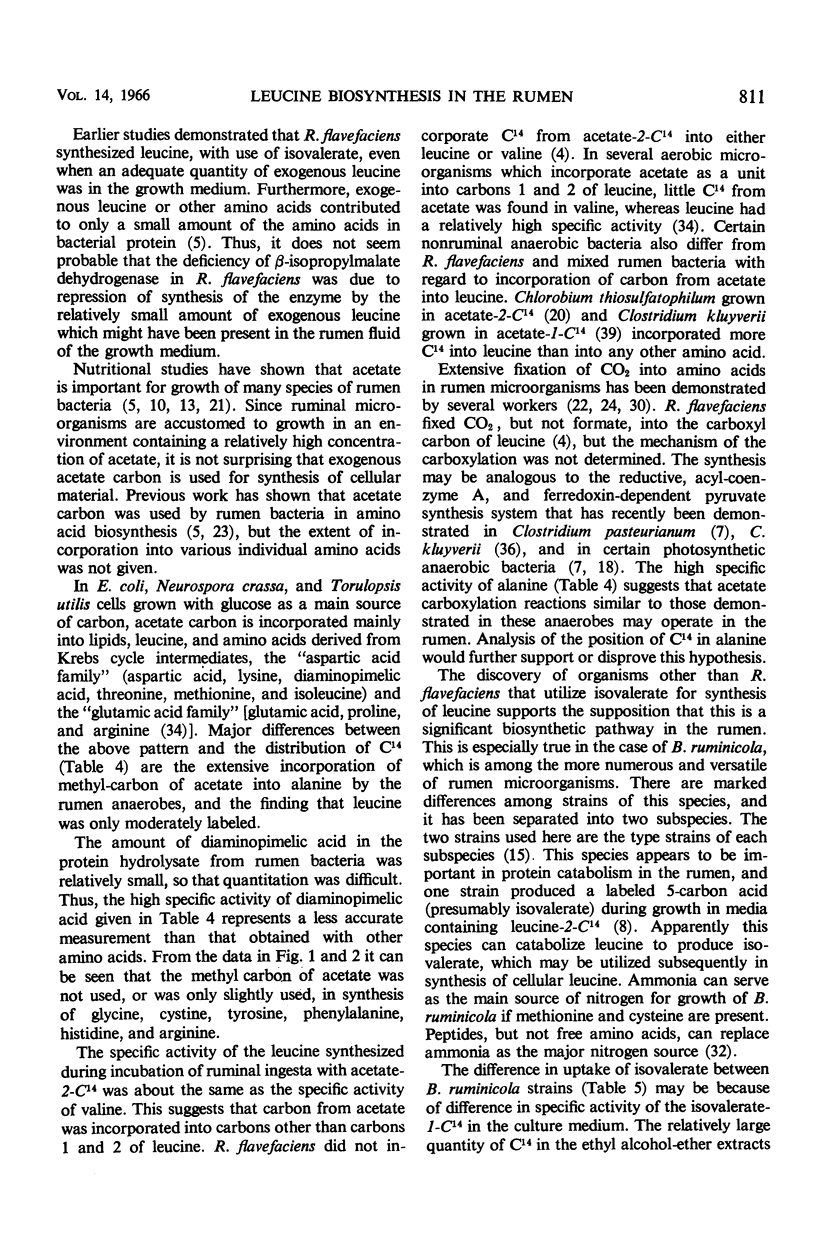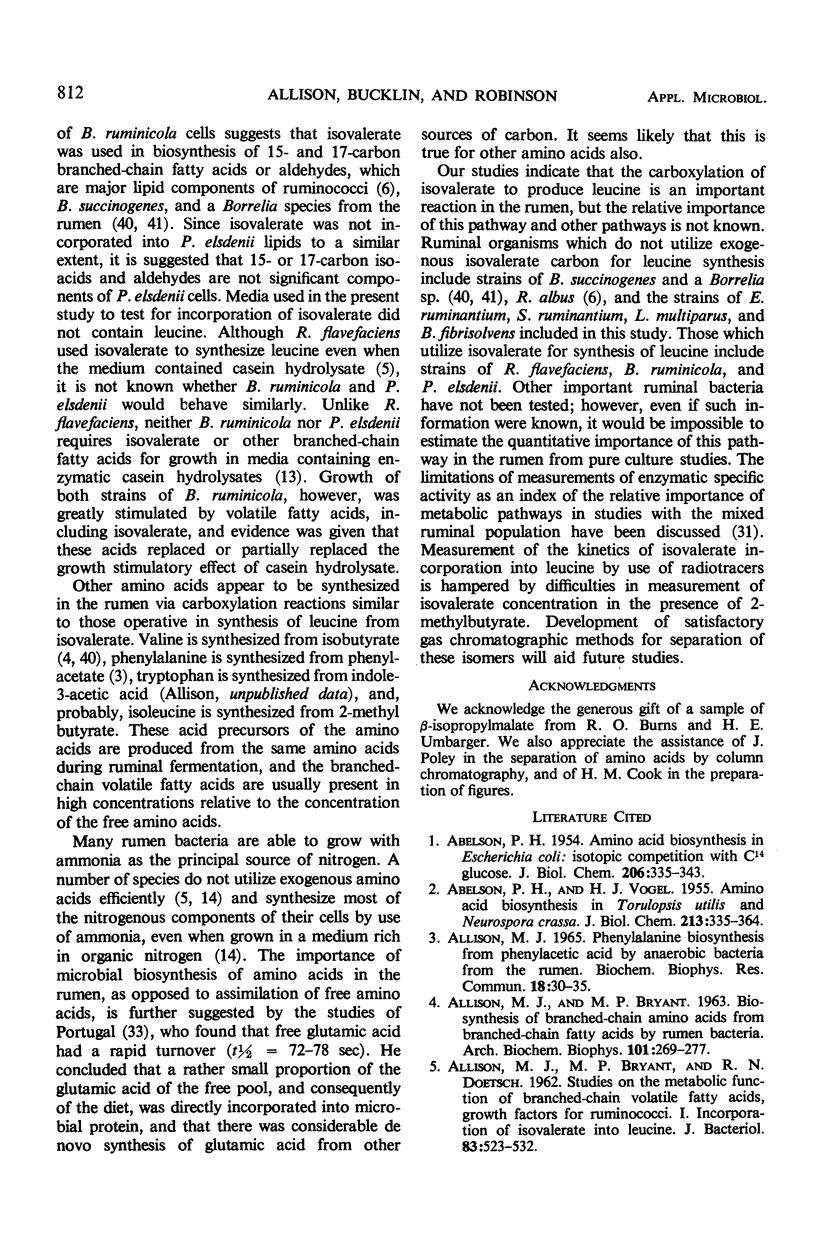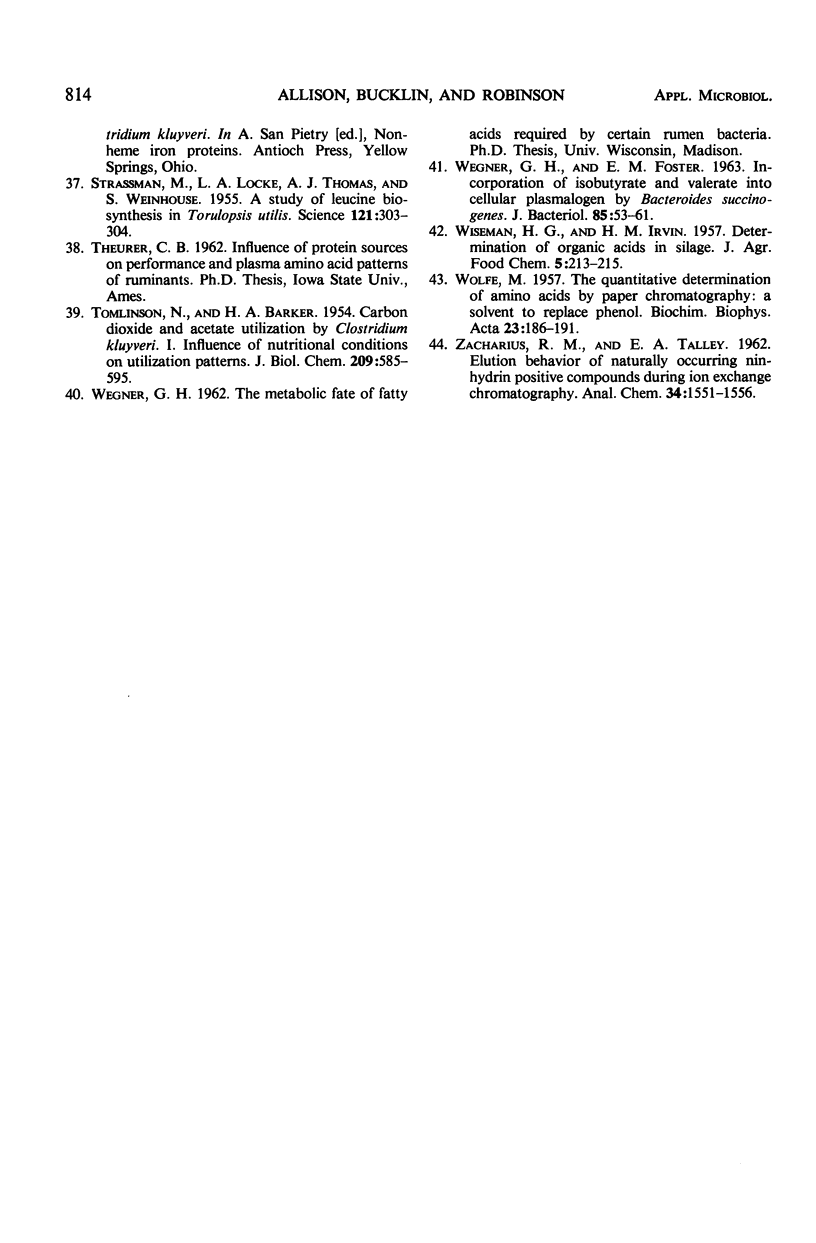Abstract
Certain anaerobic ruminal bacteria synthesize the leucine carbon skeleton by use of a pathway different from that described in other microorganisms. These organisms carboxylate the intact carbon skeleton of isovalerate, synthesizing leucine-2-C14 from isovalerate-1-C14. Strains of Bacteroides ruminicola and Peptostreptococcus elsdenii were like Ruminococcus flavefaciens in that they incorporated appreciable amounts of C14 from isovalerate-1-C14 into cellular protein and in that the only labeled amino acid found was leucine. The specific activity of β-isopropylmalate dehydrogenase in extracts from R. flavefaciens and from the mixed bacterial population from the rumen was very low as compared with the specific activity of this enzyme in extracts from Escherichia coli. This suggests that the pathway of leucine biosynthesis that operates in many aerobic and facultative microorganisms is not the major pathway in rumen bacteria. This was supported by the finding that after fermentation of whole rumen contents with acetate-2-C14, leucine from the bacterial cells had a specific activity lower than one would expect if acetate was incorporated directly into carbons 1 and 2 of leucine.
Full text
PDF







Selected References
These references are in PubMed. This may not be the complete list of references from this article.
- ABELSON P. H. Amino acid biosynthesis in Escherichia coli: isotopic competition with C14-glucose. J Biol Chem. 1954 Jan;206(1):335–343. [PubMed] [Google Scholar]
- ABELSON P. H., VOGEL H. J. Amino acid biosynthesis in Torulopsis utilis and Neurospora crassa. J Biol Chem. 1955 Mar;213(1):355–364. [PubMed] [Google Scholar]
- ALLISON M. J., BRYANT M. P. Biosynthesis of branched-chain amino acids from branched-chain fatty acids by rumen bacteria. Arch Biochem Biophys. 1963 May;101:269–277. doi: 10.1016/s0003-9861(63)80012-0. [DOI] [PubMed] [Google Scholar]
- ALLISON M. J., BRYANT M. P., DOETSCH R. N. Studies on the metabolic function of branched-chain volatile fatty acids, growth factors for ruminococci. I. Incorporation of isovalerate into leucine. J Bacteriol. 1962 Mar;83:523–532. doi: 10.1128/jb.83.3.523-532.1962. [DOI] [PMC free article] [PubMed] [Google Scholar]
- ALLISON M. J., BRYANT M. P., KATZ I., KEENEY M. Metabolic function of branched-chain volatile fatty acids, growth factors for ruminococci. II. Biosynthesis of higher branched-chain fatty acids and aldehydes. J Bacteriol. 1962 May;83:1084–1093. doi: 10.1128/jb.83.5.1084-1093.1962. [DOI] [PMC free article] [PubMed] [Google Scholar]
- ALLISON M. J. PHENYLALANINE BIOSYNTHESIS FROM PHENYLACETIC ACID BY ANAEROBIC BACTERIA FROM THE RUMEN. Biochem Biophys Res Commun. 1965 Jan 4;18:30–35. doi: 10.1016/0006-291x(65)90877-6. [DOI] [PubMed] [Google Scholar]
- BACHOFEN R., BUCHANAN B. B., ARNON D. I. FERREDOXIN AS A REDUCTANT IN PYRUVATE SYNTHESIS BY A BACTERIAL EXTRACT. Proc Natl Acad Sci U S A. 1964 Apr;51:690–694. doi: 10.1073/pnas.51.4.690. [DOI] [PMC free article] [PubMed] [Google Scholar]
- BRYANT M. P., ROBINSON I. M. Some nutritional characteristics of predominant culturable ruminal bacteria. J Bacteriol. 1962 Oct;84:605–614. doi: 10.1128/jb.84.4.605-614.1962. [DOI] [PMC free article] [PubMed] [Google Scholar]
- BRYANT M. P., SMALL N., BOUMA C., CHU H. Bacteroides ruminicola n. sp. and Succinimonas amylolytica; the new genus and species; species of succinic acid-producing anaerobic bacteria of the bovine rumen. J Bacteriol. 1958 Jul;76(1):15–23. doi: 10.1128/jb.76.1.15-23.1958. [DOI] [PMC free article] [PubMed] [Google Scholar]
- BURNS R. O., UMBARGER H. E., GROSS S. R. THE BIOSYNTHESIS OF LEUCINE. III. THE CONVERSION OF ALPHA-HYDROXY-BETA-CARBOXYISOCAPROATE TO ALPHA-KETOISOCAPROATE. Biochemistry. 1963 Sep-Oct;2:1053–1058. doi: 10.1021/bi00905a024. [DOI] [PubMed] [Google Scholar]
- Bryant M. P., Robinson I. M. Some Nutritional Requirements of the Genus Ruminococcus. Appl Microbiol. 1961 Mar;9(2):91–95. doi: 10.1128/am.9.2.91-95.1961. [DOI] [PMC free article] [PubMed] [Google Scholar]
- EHRENSVARD G., REIO L., SALUSTE E., STJERNHOLM R. Acetic acid metabolism in Torulopsis utilis. III. Metabolic connection between acetic acid and various amino acids. J Biol Chem. 1951 Mar;189(1):93–108. [PubMed] [Google Scholar]
- Evans M. C., Buchanan B. B. Photoreduction of ferredoxin and its use in carbon dioxide fixation by a subcellular system from a photosynthetic bacterium. Proc Natl Acad Sci U S A. 1965 Jun;53(6):1420–1425. doi: 10.1073/pnas.53.6.1420. [DOI] [PMC free article] [PubMed] [Google Scholar]
- FOLCH J., LEES M., SLOANE STANLEY G. H. A simple method for the isolation and purification of total lipides from animal tissues. J Biol Chem. 1957 May;226(1):497–509. [PubMed] [Google Scholar]
- HOBSON P. N., MANN S. O., SMITH W. Growth factors for Selenomonas ruminantium. Nature. 1963 Apr 13;198:213–213. doi: 10.1038/198213a0. [DOI] [PubMed] [Google Scholar]
- HUHTANEN C. N., CARLETON F. J., ROBERTS H. R. Carbon dioxide utilization by rumen microorganisms. J Bacteriol. 1954 Dec;68(6):749–751. doi: 10.1128/jb.68.6.749-751.1954. [DOI] [PMC free article] [PubMed] [Google Scholar]
- HUNGATE R. E. The anaerobic mesophilic cellulolytic bacteria. Bacteriol Rev. 1950 Mar;14(1):1–49. doi: 10.1128/br.14.1.1-49.1950. [DOI] [PMC free article] [PubMed] [Google Scholar]
- Hoare D. S., Gibson J. Photoassimilation of acetate and the biosynthesis of amino acids by Chlorobium thiosulphatophilum. Biochem J. 1964 Jun;91(3):546–559. doi: 10.1042/bj0910546. [DOI] [PMC free article] [PubMed] [Google Scholar]
- LOWRY O. H., ROSEBROUGH N. J., FARR A. L., RANDALL R. J. Protein measurement with the Folin phenol reagent. J Biol Chem. 1951 Nov;193(1):265–275. [PubMed] [Google Scholar]
- PITTMAN K. A., BRYANT M. P. PEPTIDES AND OTHER NITROGEN SOURCES FOR GROWTH OF BACTEROIDES RUMINICOLA. J Bacteriol. 1964 Aug;88:401–410. doi: 10.1128/jb.88.2.401-410.1964. [DOI] [PMC free article] [PubMed] [Google Scholar]
- Palmquist D. L., Baldwin R. L. Enzymatic techniques for the study of pathways of carbohydrate utilization in the rumen. Appl Microbiol. 1966 Jan;14(1):60–69. doi: 10.1128/am.14.1.60-69.1966. [DOI] [PMC free article] [PubMed] [Google Scholar]
- STRASSMAN M., LOCKE L. A., THOMAS A. J., WEINHOUSE S. A study of leucine biosynthesis in Torulopsis utilis. Science. 1955 Feb 25;121(3139):303–304. doi: 10.1126/science.121.3139.303. [DOI] [PubMed] [Google Scholar]
- TOMLINSON N., BARKER H. A. Carbon dioxide and acetate utilization by clostridium kluyveri. I. Influence of nutritional conditions on utilization patterns. J Biol Chem. 1954 Aug;209(2):585–595. [PubMed] [Google Scholar]
- WEGNER G. H., FOSTER E. M. Incorporation of isobutyrate and valerate into cellular plasmalogen by Bacteroides succinogenes. J Bacteriol. 1963 Jan;85:53–61. doi: 10.1128/jb.85.1.53-61.1963. [DOI] [PMC free article] [PubMed] [Google Scholar]
- WOLFE M. The quantitative determination of amino acids by paper chromatography; a solvent to replace phenol. Biochim Biophys Acta. 1957 Jan;23(1):186–191. doi: 10.1016/0006-3002(57)90302-5. [DOI] [PubMed] [Google Scholar]


